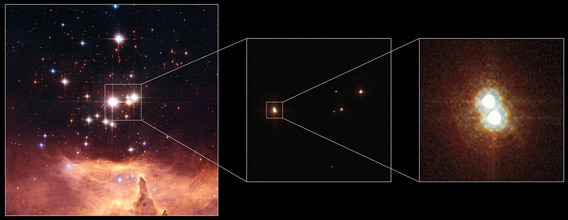Create a free profile to get unlimited access to exclusive videos, sweepstakes, and more!
Monster Triplets Inhabit the Lobster Nebula

Monsters lurk in our galaxy.
They may not look like much when you first see them. In fact, in some pictures theyâre so hard to see you need to have them pointed out to you. But thatâs OK, because sometimes the picture is so jaw-droppingly spectacular itâs no problem to gape at it:
[Oh yes, you want to click to embiggen thatâitâs only one piece of a much bigger picture that I cropped and shrank to fit the blogâor you can grab the ridiculously over-the-top 376 Mb 16,000 x 16,000 pixel version if you have a skyscraper you need to wallpaper. Image credit: ESO/VVV Survey/D. Minniti. Acknowledgment: Ignacio Toledo]
That is NCG 6357, also sometimes called the Lobster Nebula (due to its shape in visible-light images; though from what Iâve seen it looks more like a crabâ¦but that name was already taken). Itâs a massive star-forming cloud around 8000 light years away, located in the constellation of Scorpius. The picture was taken by the amazing VISTA (Visible and Infrared Survey Telescope for Astronomy), located in Paranal, Chile.
Stars form from clouds of gas and dust, and this one is very busily churning them out. And for some reasonâitâs not clear whyâsome of them are particularly beefy.
If you look above the center and to the left in the picture, youâll see a splash of wispy pink gas with a knot of blue stars next to it. Hereâs a closer look:
That cluster of stars is called Pismis 24, and the brightest star in it is called Pismis 24-1. Using various techniques to gauge the starâs physical characteristics based on its color, brightness, and so on, astronomers were shocked to find it has a mass over 200 times that of the Sun!
The thing is, thatâs impossible. I mean, impossible. Stars generate energy in their cores through nuclear fusion, slamming atomic nuclei together and freeing the energy within. The rate of this process is extremely sensitive to pressure, and that comes from the starâs mass: The more massive it is, the more tightly it can squeeze the atoms together in its core. By the time you get a star over 100 times the mass of the Sun, the amount of nuclear fusion in its core rockets upwards, releasing so much energy the star literally tears itself apart. Most stars that get near that limit undergo incredibly violent paroxysms that are second only to the star going supernova.
So right away astronomers knew Pismis 24-1 couldnât possibly be 200 times the mass of the Sun. But there was a way out:Â Maybe it wasnât one star.
Sure enough, Hubble observations of the star show it to be two stars orbiting each other very tightly. In lower resolution images they blur into one star. But it gets better: the star Pismis 24-1NE (the one on the left in the picture above) is actually itself a binary star, so close together they appear as one star even with Hubble. So Pismis 24-1 is actually three stars. This resolves (haha) the conundrum; itâs not one impossible star, itâs just three incredibly massive stars.
Each of those three stars is still crushingly huge: the one on the right is just under 100 times the mass of the Sun, and the one on the left is two stars each with about 64 times the Sunâs mass (assuming theyâre each the same size; thatâs a guess, and it may be that one is bigger and the other smaller). These stars are incredibly luminous, with a combined might that shines something like a million times brighter than the Sun. Put any one of those stars where the Sun is, and the Earth would be toast. Fried. FFfffsssssst!
Iâll note there are other huge stars in that cluster as well. Whatever is going on in NGC 6357, it loves making massive stars.
They wonât last long though. Remember when I said the rate of fusion in a starâs core goes up ridiculously quickly as the mass increases? That means the stars burn through their fuel very rapidly, and that in turn means a short lifespan. A lot of those stars are about a million years old, and I wouldnât expect them to get too much older. In a million years, maybe less, theyâll be in serious trouble. When the fuel runs out the stars canât generate energy, and itâs that energy that supports their enormous mass. The cores of the stars will collapse, setting up a complex chain of events that will end only one way: supernova. The stars will explode, one by one, blasting out so much energy that theyâll briefly become the brightest objects in the galaxy; from Earth theyâll outshine Venus in the sky!
Thatâll be quite a sight. And above that, in death, their cataclysms will create heavy elements like iron, calcium, and more that will blast outward, mingle with the gas in the nebula, and form new stars and planets. So who knows: In a few billion years, alien astronomers may look out into their night sky and wonder where their building blocks for life came from. If weâre still around, they can ask us.


























